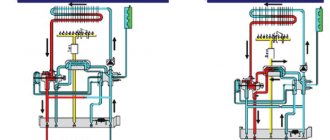Home / Gas boilers
Back to
Published: 03.06.2019
Reading time: 3 minutes
2
1326
Owners of private houses are often interested in how much gas a gas boiler consumes per month. You can find out the numbers through the correct calculations. More on how to measure gas consumption and how to reduce this level later in the article.
- 1 Approximate gas consumption 1.1 What affects gas consumption
- 1.2 How to reduce gas consumption
- 2.1 Approximate calculation of energy consumption
What is the power supply for a gas boiler?
With the advent of closed combustion chambers, gas units became dependent on electrical networks. Electricity consumption in such boilers is determined by the composition and amount of electronics in its insides.
And it is already allowed to install them not only in an isolated boiler room, but also in kitchens and bathrooms. From a security point of view, they have a high level of protection.
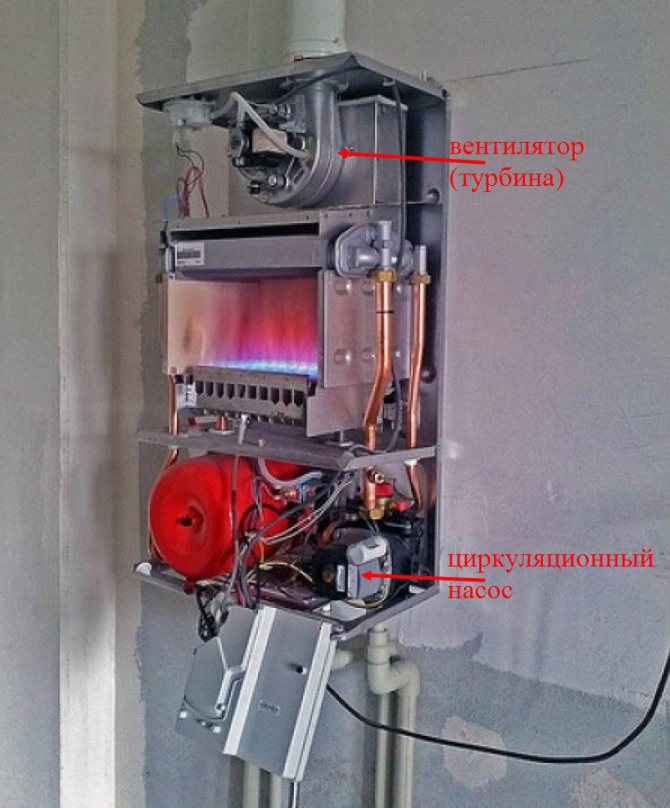
The arrows mark the main electrical consumers of the wall-mounted gas boiler - the air blower and the built-in circulation pump. In systems with a floor-standing boiler, the pump is installed separately, and in general, not one, but several pumps can be used in the heating system, and all of them will consume electricity
Let's list what exactly requires energy consumption:
- electric ignition;
- circulation pump;
- a fan in a closed combustion chamber;
- automation (gas supply regulation, as well as traction sensors, gas pressure, water pressure, etc.).
An electric ignition gas boiler ignites automatically from an electric spark. There is no ignition wick, which constantly burns in other ignition systems, at all, gas is not wasted in vain for its combustion.
At the moment of the appearance of an electric spark, some kind of electricity is spent, but the moment itself lasts a fraction of a second. In this case, electricity is consumed minuscule, gas savings due to the missing igniter covers these costs. The only negative is that in the absence of electricity, the boiler equipment cannot be started.
If the power supply to the network suddenly disappears, the gas cutoff will be triggered. When the power comes on, the electric ignition will restart the heating system again without human intervention.
The circulating pump - so it raises the power consumption dramatically! But it is possible to minimize the costs when operating a gas boiler if you use thermostats in all rooms, integrating them into the general circuit of the pump's power supply and the functioning of the boiler.
Another economic result is significantly increased by the programmer. The thermostat only helps to maintain a stable set temperature, and the programmer is able to set the day / night mode, changes by day of the week, etc.
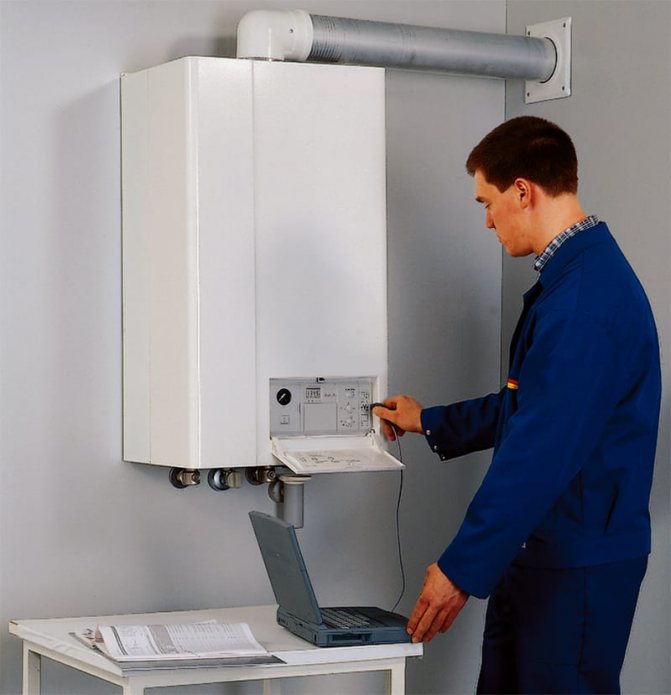

Modern automation of a gas boiler needs electricity and represents the most complex electronic devices that, without human intervention, regulate the fuel supply and the strength of the flame of gas burners, control the temperature, diagnose breakdowns
A fan (turbine) in a closed combustion chamber also consumes electricity, but less than a circular pump. The costs are justified by the improved smoke extraction. A boiler with a coaxial chimney does not burn oxygen in the room, does not allow carbon monoxide to pass outside and makes less noise.
Automation in a gas boiler increases its final cost, but with it control of the heating system is reduced to setting the desired temperature and pressing just one button.
Electricity is needed to operate the gas controller and many sensors. Its consumption depends on how complex the automation is, but in general we are talking about low-cost energy consumption.
Selecting a room thermostat - thermostat
Let us consider the choice of automation devices for controlling the heating system in a private house using the example of an equipment manufacturer of the Protherm trademark.
A room thermostat installed in the room measures the current air temperature and, if the temperature deviates from the value set in the settings, sends a control signal to the boiler.
The room thermostat, which controls the operation of the boiler, isinstalled in the largest room of the house... Radiators in the room where the thermostat is installed should not have valves that regulate the flow rate of the coolant. In other rooms, a thermostatic valve must be installed on each radiator, which regulates the flow rate of the coolant through the radiator, depending on the temperature in this room.
In heating systems with underfloor heating and radiators, the automatic air temperature control system is more complex.
Read: "Automatic control of air temperature in a house with underfloor heating and radiators".
The signal from the thermostat to the boiler can go through wires, or maybe wirelessly. In the latter version, a unit for receiving a radio signal from a wireless thermostat is installed on the boiler.
It is recommended to use thermostats of the same brand to control Protherm boilers. The manufacturer of boilers under the Protherm trademark produces several modifications of room thermostats for their gas boilers.
Gas boiler electricity consumption in figures
Usually, everyone is primarily interested in gas consumption. And the question of how much electricity a typical gas boiler consumes seems to fade into the background. Let's deal with it.
A volatile gas boiler is connected to an alternating current network with standard characteristics: 220 V and 50 Hz. For the stable operation of the unit, it is important that the voltage does not drop beyond the 195 V mark. At lower voltages, electrical components will go wild and start to shut down.
Minimum electricity consumption
The need for electricity at different stages of work is different. The minimum electrical consumption of a gas boiler is 65 W. This is in the phase of operation of the circular pump, and at the time of electric ignition - 120 W, i.e. almost twice as high. If the fan is on, then it also consumes electricity - another 30-35 watts.
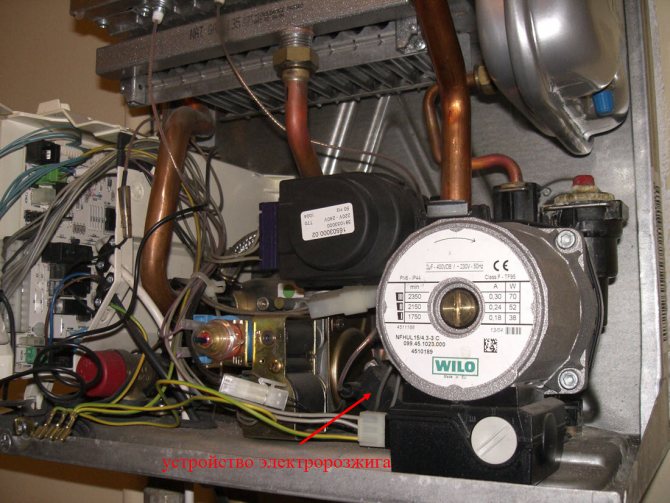

Convenience of starting the boiler, saving gas and safety due to the absence of a constantly burning igniter are the main advantages of a gas boiler with electric ignition, despite the fact that electric ignition requires electricity consumption
We draw conclusions. Electric ignition requires 120 W, then, with the pump and fan running, the power consumption will be:
65 + 30 (35) = 105 (110) W
This is the minimum daily power consumption. It does not take into account the consumption of electricity by other elements of the heating unit - the same automation. Let it be insignificant, but the final result will increase.
And it should also be noted that the figures are based on a single-circuit apparatus, i.e. only heating without hot water supply is taken into account. If we take the same thermal power, but a double-circuit boiler, the power consumption will be higher.
What does the technical passport of a gas boiler say?
In the characteristics of any gas boiler there is information about power consumption. After examining the technical documentation for the products of Bosch, Baxi, Vaillant, Ariston and others, we see that the electric power of the floor units is in the range from 100 to 200 W, and of the floor units - from 15 to 160 W.
But since in heating systems with floor-standing boilers, separately installed circulation pumps are often used. It is important not to forget about them and take into account additional power consumption.
And here is a visual comparison of power consumption in the presence of hot water supply (double-circuit boiler) and without hot water supply (single-circuit boiler): a floor-standing single-circuit with a power of 30 kW consumes 15 W, a double-circuit also with a power of 30 kW - already 150 W.


From the technical data it can be seen that the greater the thermal power of the gas boiler, the higher its demand for electrical energy.
Different manufacturers ambiguously describe their power consumption in the characteristics of gas boilers.
It can be one general line, or it can be verbose:
- electricity consumption by the pump;
- electric power without pump;
- stopping losses;
- standby consumption.
Consumption for all items is indicated in W.
Calculation of power consumption by example
To calculate the kilowatts of electricity consumed by a gas boiler, we make a classic calculation of energy consumption - the same as for other electrical appliances. We are based on the electrical power of the boiler indicated in the technical data sheet. The manufacturer sets this parameter with a maximum value that in reality exceeds the average actual indicator.
Example.
Let's say we have a single-circuit gas boiler Baxi Luna 31.310 Fi, its useful thermal power is 31 kW, power consumption is 165 W.
We calculate the daily consumption of electrical energy for the preparation of the heat carrier. We multiply the power consumption by the number of hours of operation of the boiler.
Let's say the heating does not turn off around the clock:
165 W × 24 hours = 3960 W × h or 3.96 kW × h is the maximum daily energy consumption
Now we calculate how much electricity in kilowatt-hours a gas heating boiler consumes per month. We multiply the number of consumed kilowatts per day by the number of days in a month (30 days):
3.96 kWh x 30 days = 118.8 kWh is the maximum monthly electricity consumption.
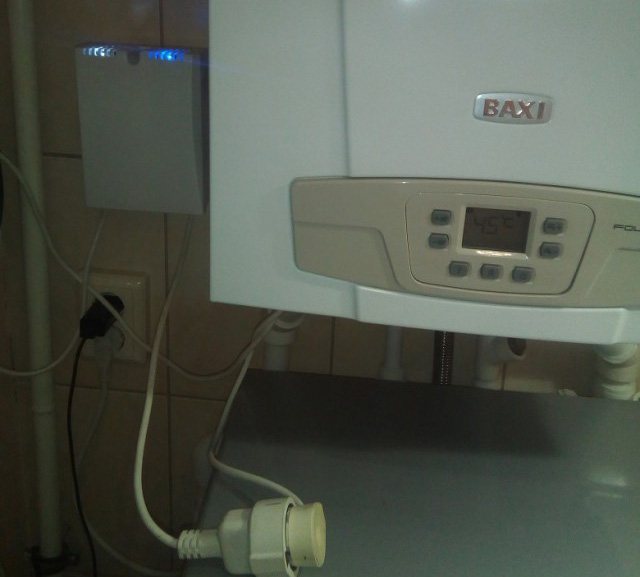

A volatile boiler does not need a natural air flow, as it has forced ventilation. Its control system is fully automated, and frost protection is turned on in the energy saving mode - the boiler periodically turns on to warm up, and the circulation pump drives the water in the system
And finally, you need to get the electricity consumption for the year or for the heating season. Since we are talking about a single-circuit boiler and, accordingly, heating without hot water supply, we take the duration of the heating season equal to 7 months.
Then: 118.8 kW × h × 7 = 831.6 kW × h - the maximum electricity consumption for the entire heating season.
For a double-circuit boiler, 12 months must be taken into account - although in an economical mode, the boiler works in the summer months.
Weather-dependent control of an electric boiler.
Despite the effectiveness of the use of thermostatic valves and room regulators to reduce the electricity consumption of an electric heating boiler, the mentioned control means are not without drawbacks. One of them is the lag effect. That is, these devices give a signal to stop the supply of heat when the temperature in the room has already reached the desired value. But since the heating system is quite inertial, thermal energy continues to be released even after the thermostat or thermostatic valve is triggered. The system of equithermal (weather-dependent) regulation is intended to help solve this problem. Its essence lies in the fact that a signal to change the operating mode of an electric boiler is given when the ambient temperature changes. Thus, with an increase in the external air temperature, the electric boiler reduces the heat output, and, consequently, the energy consumption in advance, as a result of which excessive heat generation does not occur. Weather-dependent control of an electric boiler in conjunction with room thermostats or thermostatic valves can achieve a significant effect on the economical operation of an electric boiler.
How to reduce energy costs?
We will proceed from the fact that, firstly, the electricity consumption directly depends on the heat output of the heating boiler. And, secondly, most of the electricity consumed is taken by the circulation pump, which drives the coolant in the pipes so that the pipes and heating radiators warm up measuredly.
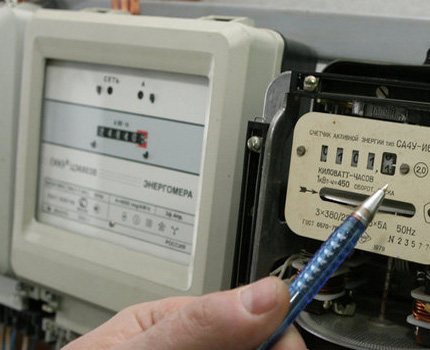

The boiler is usually always on at night from 23:00 to 06:00. Use a multi-tariff electricity meter, there are reduced prices at night
Let us name a number of specific proposals for those who would still like to reduce energy costs:
- Stop selection on the non-volatile unit. Most likely, it will be a floor version. In terms of functionality and comfort, alas, it is unable to compete with its volatile counterparts.
- Buy a volatile device, but low power. Here, of course, there is a significant limitation - one cannot ignore the number of heated square meters. If, for example, it is necessary to heat 180-200 m² of a private house, then a gas boiler with a capacity of 20-24 kW is needed. And nothing less.
- Carefully study the assortment lines of different brands. Each model has its own nuances and, perhaps, for some of them you will see the most attractive figures for power consumption in the technical specifications.
- Analyze what constitutes the total cost of electricity bills. Perhaps the share of these costs attributable to a gas boiler is negligible, and attention should be turned to other objects that really consume excessive electricity.
- And how do you like the use of alternative energy - for example, solar panels or collectors on the roof of the house?
And yet, in the pursuit of saving electricity, do not bring your own actions to the point of absurdity. Do not forget that gas units consume little electricity, since their main fuel resource is not electricity, but natural or liquefied gas.
Gas consumption calculation
For a more visual calculation of gas, consider an example. For a house of 100 sq.m. a gas boiler with a capacity of 10 kW is required. When the equipment is operating 24 hours a day, a monthly consumption of 7200 kW / hour of heat energy will be obtained. But in practice, it was found that the unit works no more than 12 hours per day, so the result obtained can be divided in half, and we get 3600 kW / h. The heating season lasts approximately 7 months. Thus, the consumption for the whole year will be 25,200 kWh. In order to generate 1 kW / hour of thermal energy, it is necessary to spend 0.1 m3 of gas. Consequently, 2520 m3 of gas will be consumed during the heating season.
But this calculation is only approximate. For an accurate calculation, it is necessary to take into account the insulation of walls, roofs, the quality of windows in the house, etc.
UPS for a gas boiler and its power consumption
In the event of a loss of electricity in the network, the gas unit will switch to an emergency worker, which threatens to break down expensive components. And the UPS (uninterruptible power supply) will come to the rescue in such situations.
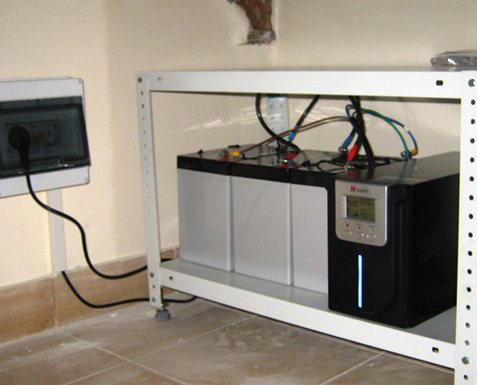

How long a gas boiler can work in the absence of electricity in the network depends on the capacity of the battery pack. Choose either a UPS with a built-in battery, or a UPS with the ability to connect the required number of battery sections to it
Line-interactive type - the most in demand UPS, according to numerous customer reviews. They include a voltage stabilizer, which is able to respond to voltage drops in the network within 10%, if this value is exceeded, a switch to power supply from a rechargeable battery follows.
Off-line type Are uninterruptible power supplies without a voltage stabilizer. They help out in case of a sudden power outage, but do not protect against fluctuations in the mains voltage.
On-line type - the most advanced UPS. They smoothly switch from mains power to battery power and vice versa. The only drawback is that not everyone can afford their price.
At the moment the gas boiler starts up, electricity consumption increases by at least two, or even three to four times. Let it be a short moment, lasting a second or two, we still take a UPS for a gas heating boiler to the maximum and with a power reserve. For a gas boiler with an electric power of 100 W, a UPS with a power of at least 300 W is needed (with a margin of up to 450-500 W).
As for the capacity of the storage battery, for example, one battery with a capacity of 50 Ah will be enough with a power consumption of 100 W for 4-5 hours of operation. To provide 9-10 hours of operation, you need to have two such batteries, etc.
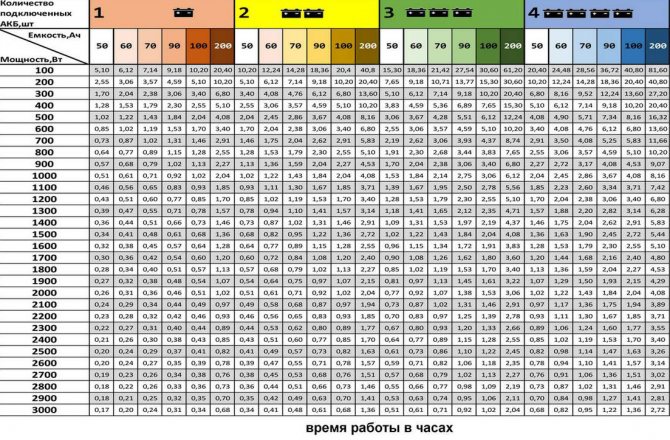

This table shows the autonomous operation of a gas boiler in hours, depending on the power consumption of the gas boiler (electric power in W), the capacity of the storage battery (capacity, Ah) and the number of simultaneously connected batteries (one, two, three or four)
And finally, will the UPS consume power for its own needs? It all depends on the efficiency. If we take the efficiency = 80%, then for our 300 W UPS the consumption together with the load will be:
300 W / 0.8 = 375 W, where 300 W is the load, the remaining 75 W is the consumption of the UPS itself.
The given calculation example is conditional and is applicable for simple uninterruptible power supplies, namely for the moment when the mains voltage surges become above a certain level - more than 10%. When the network is standard 220 V, the UPS consumes practically nothing.
It is better to entrust detailed calculations for calculating UPS power, battery capacity and additional electricity costs in connection with the installation of a UPS in the heating network.
Connecting the thermostat and outside temperature sensor to the gas boiler
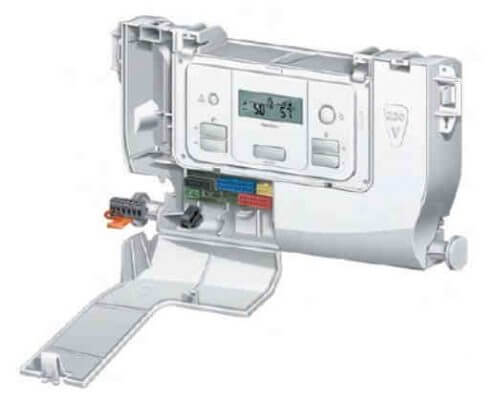

The wires from the room thermostat - thermostat are connected to the terminal block marked as X17 (in the black figure on the left) in the 24 V compartment of the control panel of the Protherm Gepard (Panther) gas boiler.
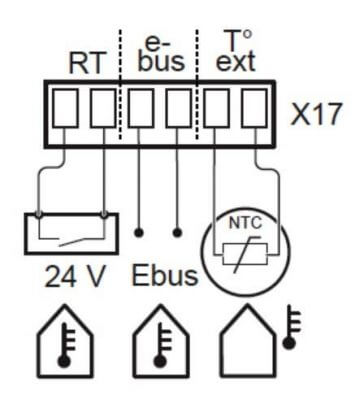

The wires from the two-position thermostat are connected on the block to the RT terminals, instead of a jumper.
The wires from the Thermolink P interface thermostat are connected to the same block, but to the terminals marked "e-Bus". Leave the jumper between the RT terminals in place.
An outdoor temperature sensor can be connected to the Toext terminals.
Connecting a two-position wireless thermostat to the boiler - video
The wireless room thermostat consists of two units.
The executive unit is installed near the boiler and connected to the boiler with wires, to the same terminals as a conventional wired thermostat. To power the executive unit, it is also connected to a 220 volt power grid.
The measuring (control) unit with the display is mounted on the wall of the heated room. The signal from the measuring unit goes to the executive unit via a radio channel.
What factors affect fuel consumption
Years of using different types of fuel have proven that gas is 30% cheaper than diesel and electricity. Most of the users are connected to a common highway, since when using gas in cylinders, money is spent on delivery.
Factors to consider when choosing a heating boiler so that there is no high fuel consumption:
- Heat loss. The consumption of a gas boiler directly depends on the heat loss through walls, windows, doors, and roofs. Therefore, preliminary calculations of the power of equipment are carried out. The area of the room, the quality of insulation, the purpose of the neighboring rooms are taken into account.
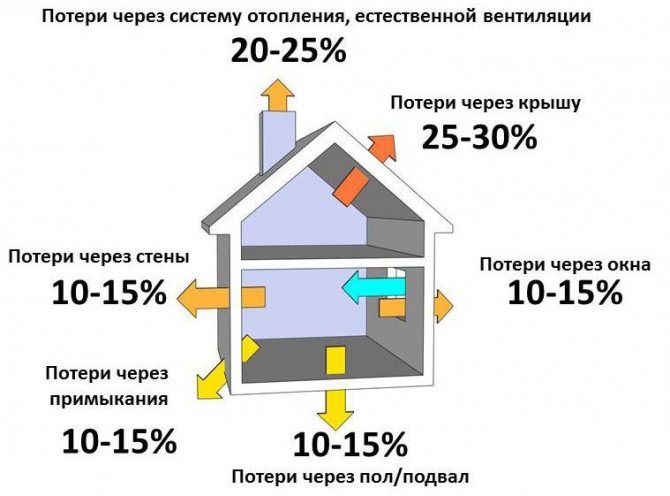

- Settings system. The automatic installation includes sensors that record the ambient temperature and adjust the operation of the unit in optimal mode. This saves on consumption.
- Vehicle type. When using a condensing unit, gas consumption is reduced by 15–20%. Unlike the conventional convection type, the condenser contains a separate heat exchanger for directing the energy of the combustion products to heat the system. This increases the efficiency (efficiency) up to 100%.


Having one or two circuits also matters. A single-circuit device works only for heating. Whereas the double-circuit is for hot water supply (DHW) and heating. Consequently, its consumption will be higher.
Units with a closed combustion chamber consume less fuel than those with an open one. The duration of the heating season also affects. Indeed, in winter, the boiler works at maximum, while in summer - at a minimum, only for heating hot water.
Why does technology consume a lot of gas? This is due to poor insulation of the building, scale deposits.
The table shows an example of the maximum consumption in 210 days.
Knowing how many cubes are consumed per hour, you will calculate the rate per day and per month.








